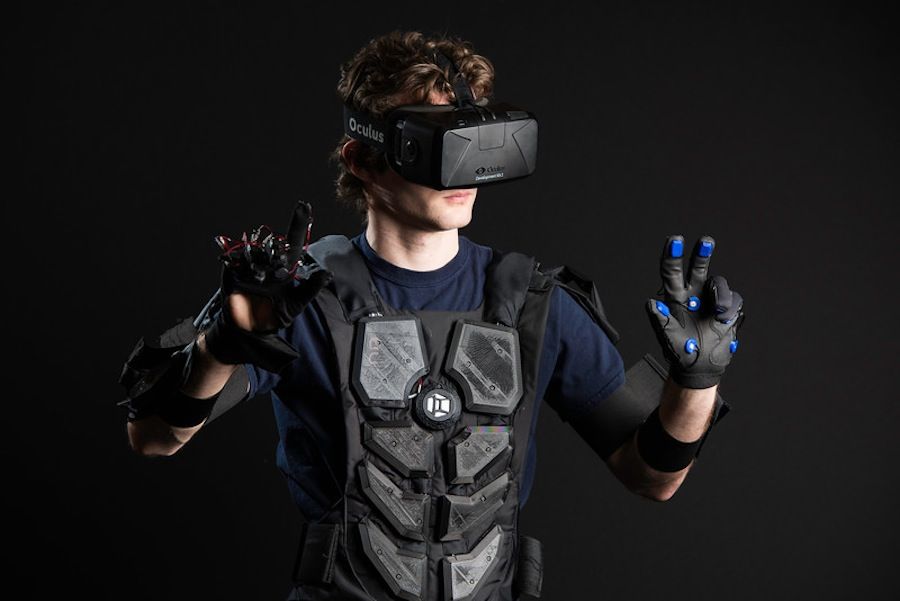
Haptic Feedback Suits and the Future of Communication
Share

Human communication has always relied heavily on touch. However, touch is often absent from our interactions in an increasingly digital world. This is especially true in virtual environments, where the lack of physical presence makes it impossible to convey touch-based communication. Fortunately, technological advances are making it possible to bridge this gap by developing haptic feedback suits. These suits, which use sensors and actuators to provide tactile feedback, can revolutionize communication in virtual environments by enabling users to feel physical sensations, such as a hug or a handshake, during remote meetings.
Human communication has always relied heavily on touch. However, touch is often absent from our interactions in an increasingly digital world. This is especially true in virtual environments, where the lack of physical presence makes it impossible to convey touch-based communication.
Thankfully, technological advances are making it possible to bridge this gap by developing haptic feedback suits. These suits, which use sensors and actuators to provide tactile feedback, can revolutionize communication in virtual environments by enabling users to feel physical sensations, such as a hug or a handshake, during remote meetings.
This article will explore the potential of haptic feedback suits for communication and their impact on virtual environments. We will also discuss the challenges and considerations involved in developing and using haptic feedback suits for communication.
What are Haptic Feedback Suits

A haptic feedback suit is a wearable device that uses sensors and actuators to provide tactile feedback to the user. These suits can simulate the touch sensation by applying pressure or vibrations to different body parts. Haptic feedback suits are being developed for various applications, including gaming, sports training, medical training, and rehabilitation.
With a more immersive and interactive experience, haptic feedback suits have the potential to revolutionize the way we interact with virtual environments and physical devices. Haptic feedback suits can assist people with disabilities by providing tactile feedback to help with mobility, balance, or orientation.
Using Haptic Feedback Suits for Communication
One of the most exciting applications of haptic feedback suits is their potential for enhancing communication in virtual environments. With the rise of remote work, people increasingly rely on digital communication tools to connect with others. However, these tools often need more tactile feedback crucial for effective communication. Haptic feedback suits have the potential to fill this gap by enabling users to feel physical sensations.
Here is some example of haptic feedback suits being used for communication:
Hug Shirt
One example of haptic feedback suits for communication is the Hug Shirt, developed by CuteCircuit. The Hug Shirt is a wearable device that simulates the sensation of a hug by applying pressure and vibration to different body parts. The shirt is equipped with sensors that detect the strength and duration of the hug and actuators that replicate the pressure and vibration of a real hug. The Hug Shirt has been used in long-distance relationships and for connecting families and friends who are separated by distance.
Tesla Suit
Another example of haptic feedback suits for communication is the Teslasuit, developed by Teslasuit Inc. It is a full-body haptic suit that provides users with sensory feedback, including tactile, thermal, and motion. The suit can simulate the touch sensation, such as a handshake or a high-five, and provide directional feedback to help users navigate virtual environments. The Teslasuit is being developed for various applications, including gaming, sports, and medical training.
Tact Suit
The TactSuit, developed by bHaptics, is a haptic feedback suit designed to enhance the user's experience in virtual environments. The TactSuit uses a wireless connection to receive signals from gaming controllers or VR headsets and provides tactile feedback in response to virtual events. For example, suppose the user is hit in a game. In that case, the TactSuit will simulate the impact sensation through vibrations and pressure. The TactSuit is also designed to work with social VR experiences, where users can feel the sensation of a high-five or a hug from other users.
The Challenges of Developing Haptic Feedback Suits
While haptic feedback suits have the potential to revolutionize communication and gaming industries, several challenges and considerations need to be considered. Firstly, the cost of haptic feedback suits can be a barrier to widespread adoption, as these suits require expensive sensors and actuators. Additionally, the suits require a wireless connection and a power source, which may only sometimes be readily available. Moreover, privacy concerns are associated with using haptic feedback suits, as these suits may collect user data for targeted advertising or other purposes.
It is important for companies developing haptic feedback suits to be transparent about their data collection practices and provide users with the option to control their data. Finally, there is a need for standardization in haptic feedback technology, as different companies may use different types of sensors and actuators, which may differ. Despite these challenges, the potential benefits of haptic feedback suits for communication and gaming make them an exciting technology to watch in the coming years.
***
Haptic feedback suits represent an exciting new frontier in communication technology, allowing users to feel physical sensations in virtual environments. While challenges remain to be addressed, such as cost, accessibility, privacy, and standardization, the potential benefits of haptic feedback suits for gaming, communication, and even medical training make them a technology to watch in the coming years.
As we continue to rely on digital communication tools for remote work and online meetings, developing haptic feedback suits could bridge the gap between virtual and physical interactions, bringing people closer together and enhancing the human experience. We can't wait to see what the future holds for this exciting technology!
If you're interested in experiencing the future of communication and gaming, consider investing in a haptic feedback suit from Atomic Gear. Our haptic feedback suits are designed to provide users with a fully immersive experience in virtual environments, with advanced sensors and actuators that simulate physical sensations in response to virtual events.
